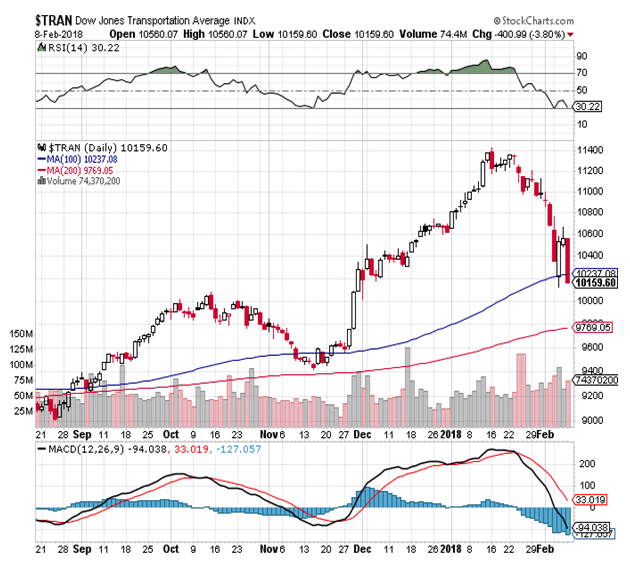This week’s “flash crash” has inflicted some technical damage on the market but nothing too serious, for the moment. However, some caution is warranted.
To gauge where the markets go from here I believe it important to focus on how the Dow Transport Index behaves, as it is the weaker of the two main Dow Indices (as was the case in 1998 and 1999, just before the tech crash of 2000). Currently, it is trying to consolidate around its 100 Daily Moving Average but I suspect new lows will be tested before too long. Remember technical analysis 101: “When significant moving averages become points of resistance rather than points of support you are in a bearish trend.”
Accordingly, please note: if the 9,440 price level is broken on the trannies the next key price point will be 9,029. Should this level fail, the Dow Transports will be in a bear market. How the Dow Industrials will react in the event of such an occurrence will be fundamental to world stock market behavior for the rest of 2018/2019.
That said, my major concern as of now is not just the technical picture of the market but its actual function, namely when it comes to New York Stock Exchange. What the “flash crash” of last Monday has shown us is that there is no real liquidity in the stock market—period (it fell 800 points in 6 minutes). In many ways, it is becoming increasingly obvious that the NYSE is no longer fit for its purpose. Too much power has been given to algo and quant trading entities to the detriment of market making professionals. How this new system is going to operate in a true bear market is anyone’s guess. Should a real bear trend develop, given what we have just experienced, a recession could be priced into the market within days or weeks instead of months and years.
Under such circumstances, it is quite possible standard sell stop execution and normal retail trading will not operate effectively, thus exposing active traders and investors to massive uncontrollable losses. See this note that appeared in the “Wall Street On Parade” blog, by Pam Martens and Russ Martens yesterday:
“The US Senate Banking Committee needs to get its act together and immediately schedule hearings on the trading outages that occurred at numerous discount brokers and mutual funds on Monday. According to thousands of on-line complaints, customers of major firms like TD Ameritrade, Fidelity, Vanguard, and T. Rowe Price could not access their accounts using the firms’ websites and thus could not place sell or buy orders as the market dove 1,597 points in mid-afternoon, then partially recovered to close down 1,175 points.”
Complaints against Fidelity included this one from a client named Lee Yih:
“The Fidelity Active Trader Platform finally loaded after 80 minutes of trying. I put in 4 orders, but nothing. No indication of orders received, no indication of an execution. I do have the order numbers, however. The website should not be giving the appearance it is up, when orders entered are swallowed up and we do not know where we stand. I called them and waited for 32 minutes on hold before giving up.”
Given this “crisis of market functionality” investors and traders who have benefited greatly from this bull market, which commenced in March 2009, might consider a more defensive strategy right now to limit potential downside losses and avoid the inevitable train wreck I see coming down the tracks. The recession catalyst I see will be the FED forced to raise interest rates quickly due to imported inflation as a result of an ever-weakening dollar. Rising interest rates will destroy sovereign fiscal policies worldwide and force growth crushing personal taxation increases. In other words, austerity will return with a vengeance.
This strategy may mean losing some profits from possible further hyperbolic market action but it means one is liquid and in a good position to take advantage of any “flash recession” and the inevitable eventual “flash recovery”. It is now obvious we are living in an altered trading environment.
Charts: Courtesy of StockCharts.Com









